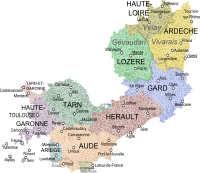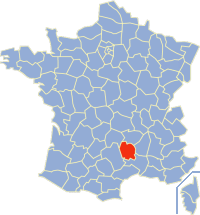Gévaudan
The Gevaudan ( Occitan Gavaudan or Gevaudan ) refers to a region in his first mention of Gaul , which is essentially in what is now the department of Lozère lay and from the Arverni strain belonging to the Gabali was inhabited, whose capital Anderitum , today Javols was.
geography

The densely wooded and sparsely populated Gévaudan belonged to the historical province of Languedoc ; it bordered the Auvergne to the northwest and the Vivarais to the east . The historical capital was Javols, and since the 10th century Mimate , about 25 km south- east , is today's Mende . The upper reaches of the Tarn River forms its southern border. The climate is more of a low mountain range and is rarely influenced by the Mediterranean Sea. The highest mountain is the Signal de Randon (1551 m) belonging to the Margeride massif .
language
A regional dialect of Occitan is spoken in Gevaudan . In the Middle Ages there were three female troubadors ( trobairitz ) who came from the Gévaudan: Almucs de Castelnou , Iseut de Capio and Azalaïs d'Altier . The following authors are to be mentioned from the modern era: Félix Remize (1865–1941, called Lo Grelhet ), Joseph Valette and Émile Tichet.
history

The area must have been inhabited as early as the Neolithic ; in any case, the numerous standing stones and dolmens near Les Bondons ( Cham de Bondon ) , about 20 km south of Mende, suggest this.
The Gabali supported Vercingetorix in the battles against Julius Caesar . After the defeat they were assigned to the province of Gallia Narbonensis and ruled from Nemausus ( Nîmes ), but were able to maintain a certain degree of independence. The Romans named the region Anderitum in Gabalum order - which later became Javols was - what the surrounding area then in the Middle Ages as Pagus Gabalum was called.
After the death of Duke Wilhelm I of Aquitaine in 918, three families fought over the successor: the Counts of Auvergne , Toulouse and Poitiers . The duke's representatives, the vice- counts of southwestern France, acquired a relative independence through this situation, which enabled them to make their office hereditary and to acquire the title of count.
The county of Gévaudan , which was created around 960, fell to Count Hugo von Rouergue from the House of Toulouse in 1033 . After Hugo's death (1053), his daughter Bertha had to fight over her inheritance with Count Wilhelm IV of Toulouse and his brother Raimund von Saint-Gilles . When Bertha died in 1065, the brothers turned against each other and only agreed after 15 years of fighting that Wilhelm Toulouse and Raimund should get the Margraviate Gothia consisting of the Rouergue, the Gévaudan and the Duchy of Narbonne . From 1085 Raimund was Count von Gévaudan, three years later he inherited the county of Toulouse .
The situation again strengthened a number of vice counties. At the end of the 11th century, the Vice Count Gilbert von Millau, a new Count of Gévaudan, appeared after he had succeeded in bringing three vice counties and thus the entire Gévaudan into his hands. The Gévaudan was inherited by marriage to the Counts of Barcelona , who became kings of Aragón . Through the Treaty of Corbeil , the Gévaudan came to France (1258) and was incorporated into the crown domain ( Domaine royal ) .
Louis VII handed over power in the region to the then Bishop of Mende through the Bulle royale du Gévaudan . The Gévaudan was divided into eight baronies, whose masters were then in permanent revolt against the Bishop of Mende. In 1307, the king and bishop signed a treaty (Traité de Pariage) by which they shared the land's income. The bishop received the title of Count of Gévaudan, the right to mint and the lower justice. In the Huguenot Wars (1562–1598) and thereafter, the Gévaudan suffered considerable damage from regular or free-riot troops from both sides. Nominally the Gévaudan belonged to the province of Languedoc , but had its own Estates General (états généraux) until the outbreak of the French Revolution in 1789 .
When the départements were created in France in 1790 , the Gévaudan was assigned to the Lozère département ; The exception was the canton of Saugues , which has since been part of the Haute-Loire department .
See also
Web links
- Gevaudan and the history of France - photos and information (French)
- Counts of Gévaudan 915–1111 (French)
- Municipalities in Gevaudan - interactive map + info (French)

